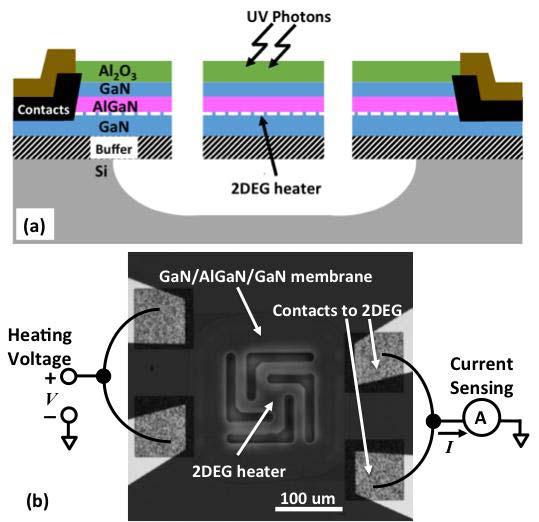- News
28 November 2016
Persistent photoconductivity in nitride semiconductor UV photodetectors
Stanford University in the USA has used localized heating to reduce persistent photoconductivity (PPC) in aluminium gallium nitride on gallium nitride (AlGaN/GaN) ultraviolet (UV) photodetectors [Minmin Hou et al, IEEE Electron Device Letters, published online 8 November 2016]. In particular, the PPC was reduced by more than three orders of magnitude from 39 hours to 24 seconds.
PPC is the time needed for the device to reset for its next detection sequence. The PPC of AlGaN/GaN photodetectors is typically between hours and days, making such devices unsuitable for most applications. The Stanford device suspended the AlGaN/GaN material of the photodetector, removing its thermal connection to the underlying silicon substrate. This allows the device to be locally heated to around 300°C, accelerating the capture of photo-generated carriers.
The researchers suggest that improved AlGaN/GaN photodetectors could find application in solar UV monitoring, satellite orientation, and combustion flame detection. Designers of military/defense systems use combustion flame detection for missile and anti-missile targeting.
The Stanford UV photodetectors were fabricated on AlGaN/GaN (30nm/1.5μm) on (111) silicon wafers with a GaN capping layer. The metal-organic chemical vapor deposition (MOCVD) material was supplied by Dowa Co. The electron mobility in the two-dimensional electron gas (2DEG) channel was 1400cm2/V-s with 0.9x1013/cm2 carrier density.

Figure 1: (a) Schematic cross-section and (b) photograph with schematic for electrical connections of micro-fabricated and fully suspended AlGaN/GaN UV photodetector with integrated 2DEG heater.
Fabrication (Figure 1) consisted of mesa plasma etch, deposition of titanium/aluminium/platinum/gold ohmic contact electrodes, rapid thermal annealing, and further etching to suspend the photodiode structure above the silicon substrate. The suspension etch used an isotropic process involving xenon difluoride. The arms of the suspended region were 100μm long and 20μm wide. The center plate was 50μmx50μm.
Suspending the photodetector somewhat reduced the photo-to-dark-current ratio (PDCR = (photo-dark current difference)/(dark current)). For 15V applied voltage, the reduction was from 1 to 0.09. This reduction was more severe at 30V, from 0.18 for a solid device without suspension to 0.04 with.
The low PDCRs are related to the relatively low intensity of the incident UV light with a power density of around 0.5mW/cm2. The reductions for the suspended device are related to the temperature increase from Joule heating that reduces both carrier mobility (phonon scattering) and density (strain relaxation decreasing piezoelectric charge polarization) of the 2DEG.
Modeling of the solid device suggests that the temperature increase at 30V applied voltage was only about 1.5°C above room temperature due to the heat-sinking effect of the silicon substrate. Simulations of the suspended device indicated a temperature increase to the order of 270°C at 30V.

Figure 2: Transient photocurrent response of (a) solid and (b) fully suspended AlGaN/GaN UV photodetectors under dark and 365nm illumination. (c) Normalized photocurrent values (0% dark, 100% maximum photocurrent under UV illumination).
PPC was reduced by heating from 39 hours (1.4x105 seconds) with 1V applied to 24 seconds with 30V. The results give a capture barrier estimate of around 360meV. Previous researchers have suggested that the barrier is related to non-overlapping vibronic states of filled and unfilled defects. Thermal energy at high temperature (~50meV average at 300°C compared with 26meV at room temperature) increases the likelihood for electrons to be at high enough energy for capture, reducing the decay time.
The researchers comment: "The heating power and voltage can be reduced by optimization of the 2DEG heater size and layout. Since the AlGaN/GaN photodetector has a much shorter thermal time constant than its photocurrent decay time, pulsed heating can be utilized to further reduce power consumption. Future work can be conducted to study the effects of pulsed heating on PPC suppression."
AlGaN/GaN UV photodetectors MOCVD
http://dx.doi.org/10.1109/LED.2016.2626388
The author Mike Cooke is a freelance technology journalist who has worked in the semiconductor and advanced technology sectors since 1997.


